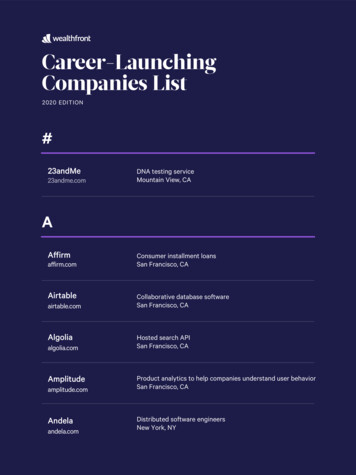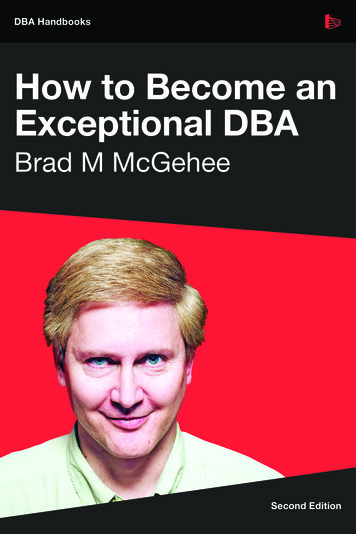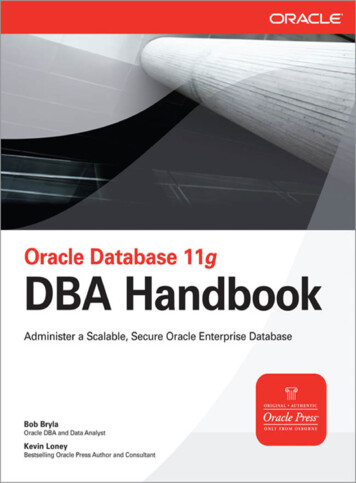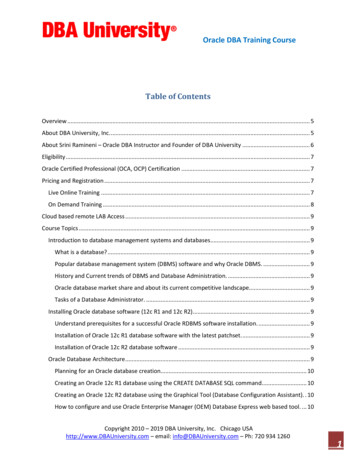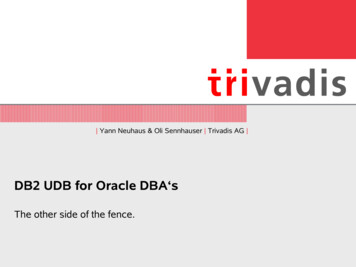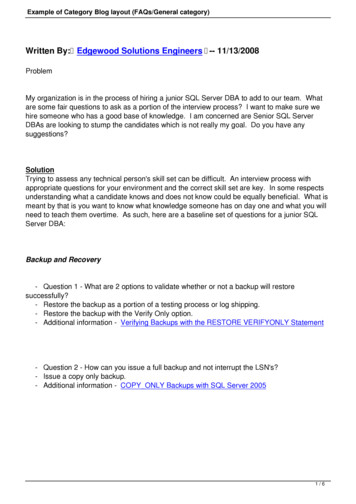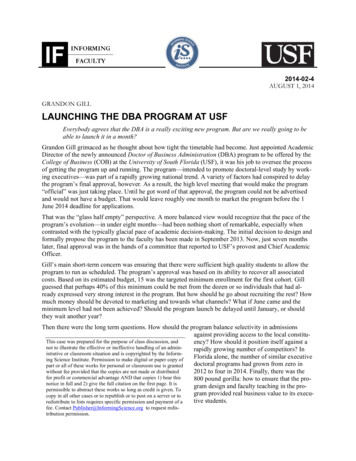
Transcription
2014-02-4AUGUST 1, 2014GRANDON GILLLAUNCHING THE DBA PROGRAM AT USFEverybody agrees that the DBA is a really exciting new program. But are we really going to beable to launch it in a month?Grandon Gill grimaced as he thought about how tight the timetable had become. Just appointed AcademicDirector of the newly announced Doctor of Business Administration (DBA) program to be offered by theCollege of Business (COB) at the University of South Florida (USF), it was his job to oversee the processof getting the program up and running. The program—intended to promote doctoral-level study by working executives—was part of a rapidly growing national trend. A variety of factors had conspired to delaythe program’s final approval, however. As a result, the high level meeting that would make the program“official” was just taking place. Until he got word of that approval, the program could not be advertisedand would not have a budget. That would leave roughly one month to market the program before the 1June 2014 deadline for applications.That was the “glass half empty” perspective. A more balanced view would recognize that the pace of theprogram’s evolution—in under eight months—had been nothing short of remarkable, especially whencontrasted with the typically glacial pace of academic decision-making. The initial decision to design andformally propose the program to the faculty has been made in September 2013. Now, just seven monthslater, final approval was in the hands of a committee that reported to USF’s provost and Chief AcademicOfficer.Gill’s main short-term concern was ensuring that there were sufficient high quality students to allow theprogram to run as scheduled. The program’s approval was based on its ability to recover all associatedcosts. Based on its estimated budget, 15 was the targeted minimum enrollment for the first cohort. Gillguessed that perhaps 40% of this minimum could be met from the dozen or so individuals that had already expressed very strong interest in the program. But how should he go about recruiting the rest? Howmuch money should be devoted to marketing and towards what channels? What if June came and theminimum level had not been achieved? Should the program launch be delayed until January, or shouldthey wait another year?Then there were the long term questions. How should the program balance selectivity in admissionsagainst providing access to the local constituThis case was prepared for the purpose of class discussion, andency? How should it position itself against anot to illustrate the effective or ineffective handling of an adminrapidly growing number of competitors? Inistrative or classroom situation and is copyrighted by the InformFlorida alone, the number of similar executiveing Science Institute. Permission to make digital or paper copy ofdoctoral programs had grown from zero inpart or all of these works for personal or classroom use is grantedwithout fee provided that the copies are not made or distributed2012 to four in 2014. Finally, there was thefor profit or commercial advantage AND that copies 1) bear this800 pound gorilla: how to ensure that the pronotice in full and 2) give the full citation on the first page. It isgram design and faculty teaching in the propermissible to abstract these works so long as credit is given. Togram provided real business value to its execucopy in all other cases or to republish or to post on a server or totive students.redistribute to lists requires specific permission and payment of afee. Contact Publisher@InformingScience.org to request redistribution permission.
2014-02-4GILLDoctoral Programs in Business 1Compared with other academic fields of study, business has a relatively short history. Prior to the early1900s, relatively few business schools existed (with University of Pennsylvania’s Wharton School of Finance and Dartmouth University’s Tuck School being the two earliest), and the MBA degree, introducedby Harvard Business School, was barely a century old. Even these early programs at prestigious institutions were viewed as being far less rigorous than their liberal arts counterparts—such as economics. Theirresearch was, for the most part, considered anecdotal and “lightweight”, a stinging criticism in the mindof many academics. There was some justification for these characterizations. In point of fact, most facultymembers did not hold terminal degrees and, to the extent they did, these degrees were often in fields thatwere at best peripherally related to business.In the late 1950s, the situation came to a head after the publication of two widely circulated reports (supported by the Ford and Carnegie foundations) that offered stinging criticisms of business education andresearch. Largely in reaction to these criticisms, and with foundation support, in the 1960s academic business research and education began a transformation that continued for several decades. Large numbers ofbusiness doctoral candidates were trained in new theoretical and empirical research methods emergingfrom statistics, economics, and social sciences (such as psychology and sociology). Institutions raisedtheir standards for research and publication. In the process, business scholars gained greater respect acrossthe broader academic community.As a result of their focus, business Ph.D. programs offered by research institutions in the U.S. were seenstrictly as a pathway to an academic career. While some graduates did go into other occupations, such asmanagement consulting, most programs viewed such career decisions with disappointment. In this respect, U.S. attitudes differed from those in certain other countries. Germany, in particular, had a largenumber of doctorates in its executive ranks—as high as 80% of large company CEOs by some estimates.Most of these individuals, however, held doctorates in non-management disciplines, such as engineering.Outside of research universities, the situation was somewhat different. Many online universities, such asthe University of Phoenix, University of Maryland, and University College, offered Ph.D. programs inbusiness that could be pursued part-time. The same was true of a number of regionally focused universities, such as Nova Southeastern. While these programs were generally accredited, either by regional oronline accrediting agencies, they tended to lack accreditation by the main business accrediting agency,AACSB International. The practical impact of that was to limit the degree to which credits could be transferred across programs. It also meant that AACSB-accredited schools would not normally employ thesegraduates as faculty members, particularly for tenure earning positions.U.S. Executive Doctoral Programs in BusinessIn recent years, a number of U.S. institutions accredited by AACSB International began to offer a newtype of program that fell outside the academic Ph.D.: the Executive Doctorate in Business (EDB). Although the specific degree awarded varied from institution to institution, with Doctor of Business Administration (DBA) being the most common, they shared a number of features that distinguished them fromthe traditional business Ph.D. Broadly speaking, these programs served a different set of needs than thePh.D. (see Exhibit 1). They also tended to share a number of common characteristics (see Exhibit 2).The first program in this new category was introduced by Case Western Reserve University in 1993, itsExecutive Doctor of Management (later renamed Doctor of Management). For over 15 years, they represented the only such program in the U.S. In 2009, however, the landscape began to change dramaticallyas new programs were introduced. This growth and the associated programs are illustrated in Exhibit 3.12Adapted from Gill, T.G. (2013). Executive doctorate in business at USF. USF Case Study.Informing Faculty, 2014, Vol. 2, No. 4, pp 1-30
2014-02-4DBA at USFTypes of curriculaIn analyzing the curriculum content of executive doctoral programs, both in the U.S. and abroad, Gillidentified four broad categories of programs: publication, disciplinary, multi-disciplinary, and interdisciplinary. As illustrated in Exhibit 4, these programs all tended to have research methods content nearthe beginning and a dissertation or project at the end. Where the designs differed was in the middle. As hedescribed them in his blog:1. By publication. Typical of many European programs, although not in the U.S. Students get sometraining in research methods and then proceed directly to their dissertation without much–if any–coursework. The Ph.D. is awarded based upon the resulting publication(s).2. Disciplinary. A direct mapping from the regular Ph.D. to the executive doctorate. Coursework isfocused on a specific discipline, often through the use of electives. Students write functional dissertations.3. Multi-Disciplinary. Survey courses are presented in each functional research area, making thecoursework look superficially similar to an MBA (although the content is more focused on the research literature). Students would normally write functionally-oriented dissertations.4. Inter-disciplinary. Coursework focuses on topics that do not easily fall within a single businessfunction, such as systems theory, analytics, and innovation. Dissertations will often have an interdisciplinary flavor.Gill continued with his personal assessment of the pros and cons of each design:1. By publication. Particularly well-suited for individuals who know precisely what questions theywant to study prior to entering a program. In Europe, the master’s degree often provides thisbackground. The nature of the degree makes it difficult to translate into credits, which mightprove an obstacle to teaching at U.S. institutions.2. Disciplinary. This doctorate is probably best suited to individuals who would like to make contributions to the academic literature, which tends to break down along functional lines. Since business problems rarely break down into purely functional problems, it may prove more difficult toapply to practical problems. Students also should have a good idea of what functional area theyplan to concentrate in prior to entering the program.3. Multi-Disciplinary. Tends to offer a breadth of research literature coverage, well-suited to students who are not sure where their interests lie. Might be particularly useful for executives coming in without a broad-based business degree, such as an MBA. The drawback is that the coverage of so many areas may lead to superficial treatment. Also, it is not clear that the functional research literature is a particularly good source of insights for practice, and executives already practicing in a particular function may find much of it insipid, if not unbelievable.4. Inter-disciplinary. The content of the curriculum for these programs varies widely, as being interdisciplinary opens up a wide range of possibilities. The inter-disciplinary flavor will, however,provide executives with exposure to areas where they are unlikely to have previous familiarity.Also, the inter-disciplinary focus may make it easier to map what has been learned to “realworld” problems.Of the U.S. programs, Gill characterized the CWRU Doctor of Management as being an excellent exemplar of the inter-disciplinary approach. As shown in Exhibit 5, its course offerings did not fit neatly intotypical business functions, instead being focused on systems thinking. The curriculum of Georgia StateUniversity’s Executive Doctorate in Business was similarly constructed.Informing Faculty, 2014, Vol. 2, No. 4, pp 1-303
2014-02-4GILLOklahoma State University’s Ph.D. for Business Executives represents an exemplar of the disciplinaryfocus, faithful to its Ph.D. namesake. Unique among these programs, it offered 3 concentration courses(see Exhibit 6) that allow the student to specialize in a function.Most recently, a number of multi-disciplinary programs had been launched or announced. Two of thesehappened to be within a two hour drive of the University of South Florida and were, therefore, of particular interest. A third Florida program, at AACSB-accredited Jacksonville University, was also scheduled tolaunch in fall 2014. A private university located about 4 hours from USF, and away from other majorFlorida population centers, it was not deemed to be as much of a competitive threat.Local Competing ProgramsIn fall 2012 the USF COB had first begun exploring the possibility of offering an executive doctorate. Atthat time, the closest similar program was offered by Georgia State University, in Atlanta. In spring 2013,that situation changed when Rollins College—located in Winter Park, about a 90 minute drive to the westof USF—announced it was launching a program in fall 2013. Rollins was a small liberal arts school thatwas frequently ranked #1 among undergraduate regional schools in the South. Its only graduate programswere the various MBA programs offered by its Crummer Graduate School of Business. Both its part-timeand Executive MBA programs were ranked highly (at or near the top) among Florida programs. The Executive DBA was to be its first foray into doctoral education. It had launched on schedule in the fall, witha cohort of 13 (three more students than its target of 10). For the fall 2014 cohort, it had raised its 3-yeartotal cost over 10,000 from its original 68,000 offering price.In fall 2013, the University of Florida (UF)—the state’s well known flagship university located inGainesville, about 2 hours north of USF—announced that it would be offering a market rate DBA program. A market rate offering differed from the “cost recovery” model being launched by USF in twoways:1. It was allowed to have revenues in excess of costs2. It required approval from the Florida Board of Governors, the body responsible for oversight ofthe state university system. That approval was received in November 2013.Similar to cost recovery programs, the authorization of the UF DBA was dependent upon the fact that UFwas already offering Ph.D. degrees in business. That meant that the DBA did not represent a new degree,only a new variation on the existing degree. This distinction was crucial, since new Ph.D. degrees required a lengthy approval process, often taking 5 years or more. The first public presence of the UF DBAappeared in early 2014, when the program website was unveiled.The curriculum and costs of the two Florida programs are summarized in Exhibit 7. Based upon the curricula posted on their websites, both appeared to be leaning heavily towards the multi-disciplinary model.Both had a full set of functional offerings and courses of a type frequently found in MBA programs(bolded in the Rollins slide in Exhibit 7; highlighted in the UF slide in Exhibit 7). From a faculty assignment standpoint, such a curriculum was the easiest to support, since it mimicked the course subject areastaught in MBA and Ph.D. programs, as well as the research areas of most faculty members. In doing so,however, both programs departed significantly from the highly successful CWRU and GSU programs,both of which were interdisciplinary.On a cost basis, the programs were reasonably close. The 90,000 3-year price at UF included meals,books and a computer. The Rollins 3-year price of 78,500 included none of these, making its effectivecost (for comparison purposes) somewhere closer to 85,000.4Informing Faculty, 2014, Vol. 2, No. 4, pp 1-30
2014-02-4DBA at USFThe USF College of Business 2Over its short lifetime, the University of South Florida, located in Tampa, had experienced a rise in stature matched by few other institutions in the world. Founded in 1956, by 2013 the university had transformed itself into a system soon to consist of three separately accredited institutions (the Tampa/Maincampus, USF St. Petersburg, and USF Sarasota/Manatee) that covered most of the west-central region ofthe state. It was the eighth largest public university in the U.S. and was among 108 institutions classifiedby Carnegie as research university/very high (RU/VH).With around 6,000 students, USF’s College of Business (COB) was second in size only to USF’s Collegeof Arts & Sciences. In addition to its SACS regional accreditation (shared with the university as a whole),its business and accounting programs were accredited by AACSB International. The college reported approximately 105 faculty/staff (full time equivalent) and a 15 million operating budget.The largest programs in the COB were its undergraduate programs in business and accounting, with totalenrollment of approximately 5,000. At the graduate level the college boasted a wide range of programs,including doctoral degrees, disciplinary master’s degree programs, an MBA program and an ExecutiveMBA program. Recently, the COB’s Information Systems & Decision Sciences department Master of Science in MIS (MS-MIS) program garnered considerable university attention as a result of having well inexcess of 800 applicants for slots in fall 2014, nearly all of whom were international students.A particular area of challenge for the College related to its PhD. programs, described as follows on theCollege’s website:Doctoral programs at the USF College of Business are specifically designed for scholars who aspire to become research faculty at top-tier institutions worldwide. Transforming young scholarsinto world-class researchers, this rigorous PhD program provides students with broad training inthe latest research methodology as well as experience in the business classroom.The USF College of Business is committed to providing scholars with the coursework and handson inquiry to enable their research and discovery to be published in high-quality academic journals. The College provides a level of training that will bring students to the forefront of their chosen area of study. Candidates are mentored as they complete independent inquiry and enjoy numerous opportunities to work side-by-side with respected research faculty in collaborative research programs.Placement assistance is provided as graduates begin their academic careers at leading research institutions.PhD concentrations are offered in the areas of accounting, finance, marketing, and informationsystems.In many respects, these programs were exemplary—offering rigorous training to students and experiencing student attrition rates that were far lower than some of its peer competitors. The faculty membersteaching in the programs were also internationally renowned—at least two of USF’s departments had faculty research or program rankings in the top 50 (out of more than 4,000 higher education institutions inthe U.S.) Unfortunately, its placement record at “top-tier institutions” was far below what the quality ofits programs would imply.2The next two sections are adapted from Gill, T.G. (2013). Executive doctorate in business at USF. USF CaseStudy.Informing Faculty, 2014, Vol. 2, No. 4, pp 1-305
2014-02-4GILLUSF DBA ProgramThe initial impetus for launching an executive doctorate at USF resulted from a conversation between Dr.Moez Limayem and Gill. Limayem, the former Associate Dean at the Sam Walton College of Business atthe University of Arkansas, had just joined the USF College of Business as dean in July 2012. Upon arriving at the college, he announced that he would be making no major changes until he had spoken one-onone with each of the full-time faculty members. True to his word, he had scheduled nearly 100 meetings(up to an hour each) over a two month period. At each meeting, his central question had been the following: What are your ideas for making the USF College of Business better?At one of these meetings, he was surprised to hear Grandon Gill, professor in the Information Systems &Decision Sciences (IS&DS) department, proposing an idea that Limayem himself had been aggressivelypursuing prior to leaving his previous position: launching an executive doctorate. Perhaps even more surprising, Gill had published research on th
2014-02-4 . AUGUST 1, 2014 . GRANDON GILL . LAUNCHING THE DBA PROGRAM AT USF. Everybody agrees that the DBA is a really exciting ne



